《Terraform 101 從入門到實踐》這本小冊在南瓜慢說官方網站和GitHub兩個地方同步更新,書中的示例代碼也是放在GitHub上,方便大家參考查看。 簡介 Azure是微軟的公有雲,它提供了一些免費的資源,具體可以查看: https://azure.microsoft.com/en-us/ ...
《Terraform 101 從入門到實踐》這本小冊在南瓜慢說官方網站和GitHub兩個地方同步更新,書中的示例代碼也是放在GitHub上,方便大家參考查看。
簡介
Azure是微軟的公有雲,它提供了一些免費的資源,具體可以查看: https://azure.microsoft.com/en-us/free/
本章將介紹如何通過Terraform來使用Azure的雲資源。
註冊Azure賬號
首先要註冊一個Azure賬號,我選擇用GitHub賬號登陸,免得又記多一個密碼。
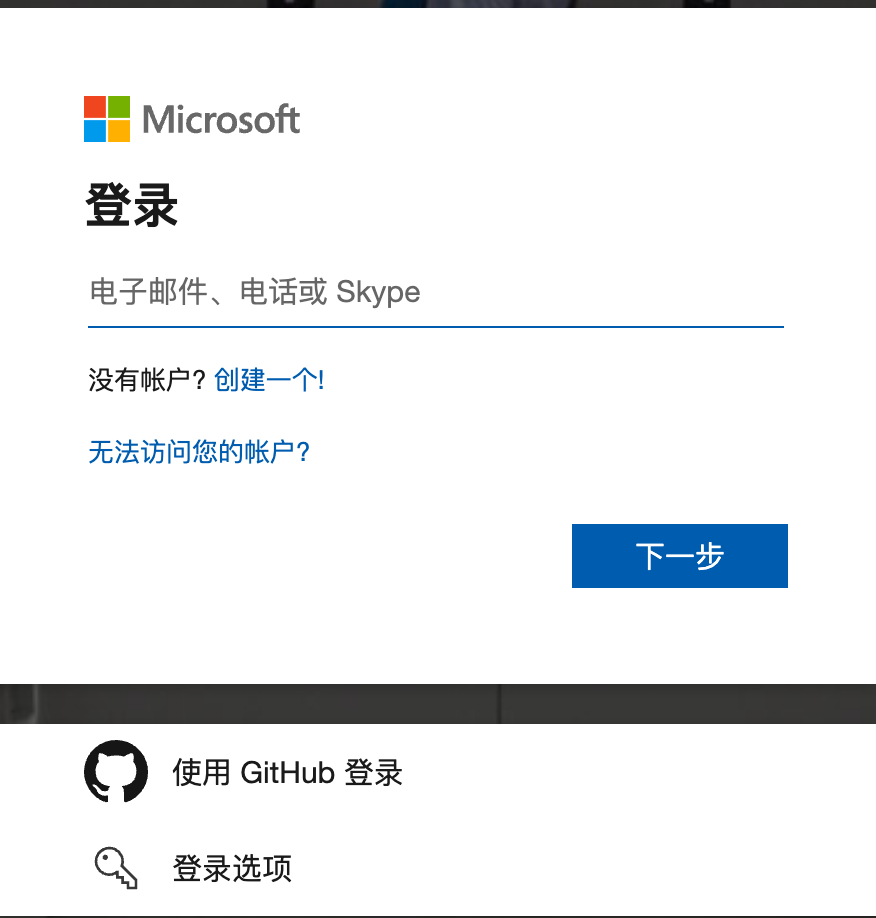
跳到GitHub,同意即可:
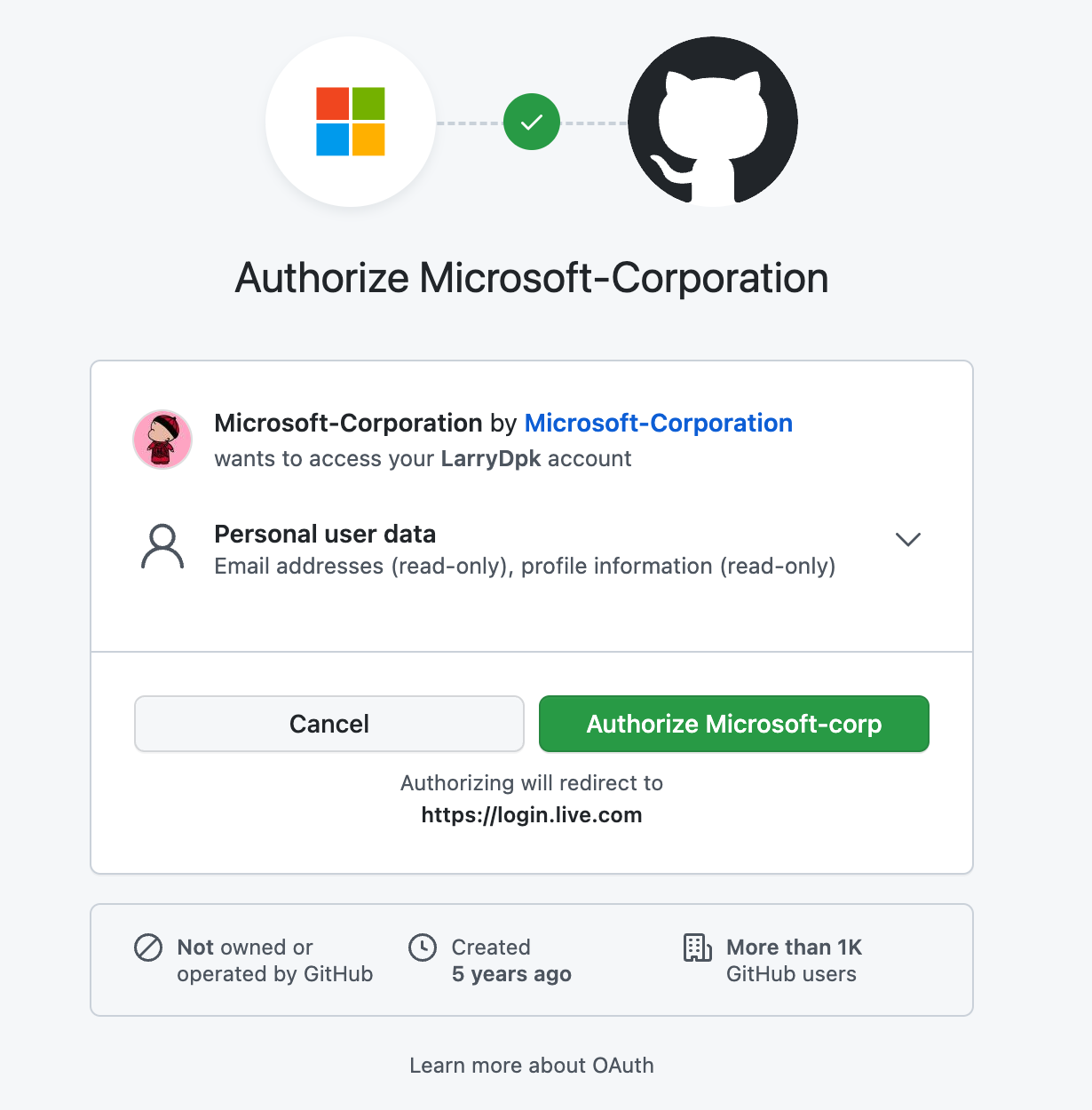
創建賬號時,有一些信息要填,特別是郵箱和手機號比較關鍵:
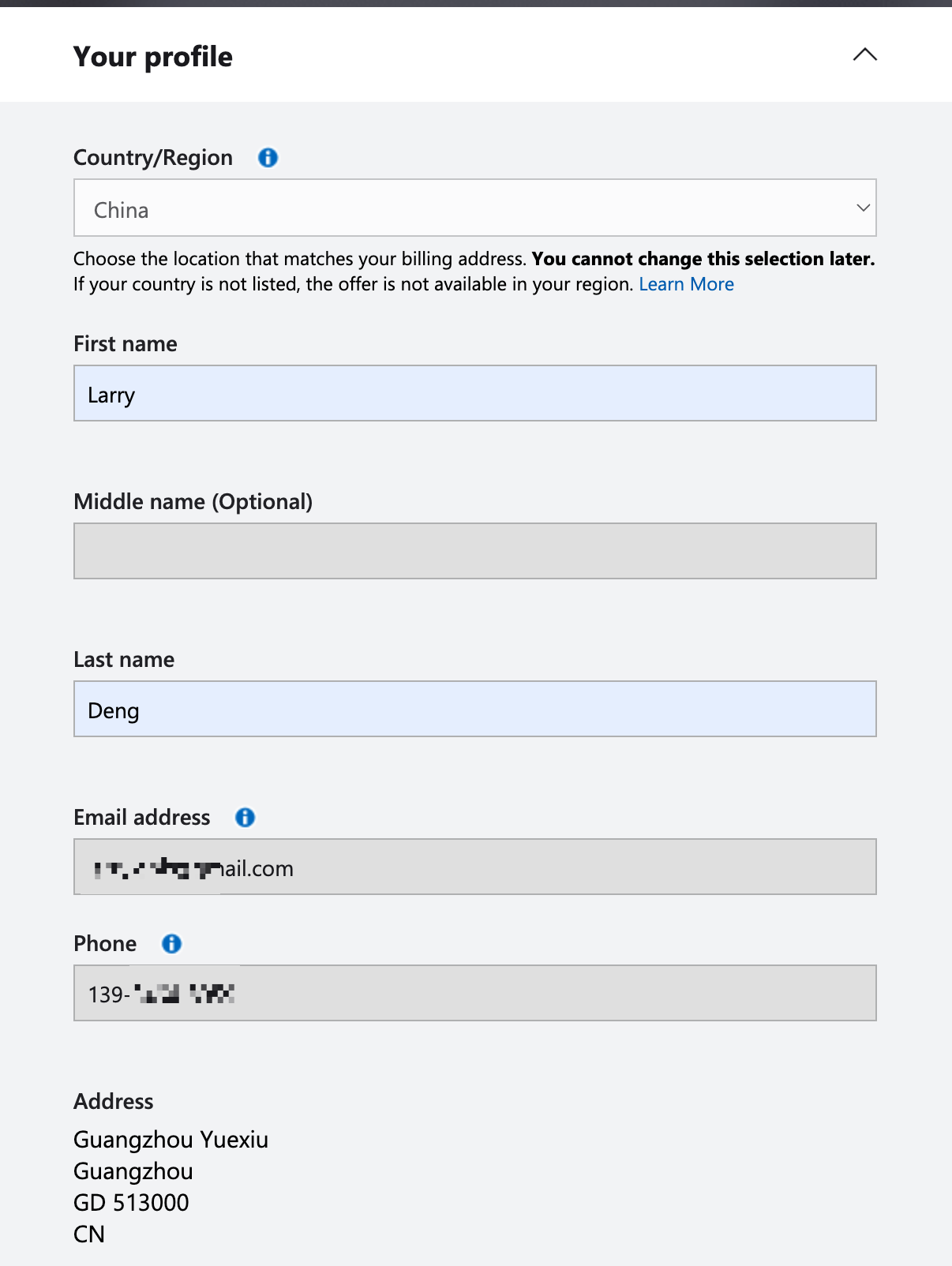
同時還需要一張Visa或Master卡,我是有一張Visa的卡,填好後會有一個0元的扣費,不要擔心。下麵Cardholder Name我填的中文名字,註冊成功了。

0元扣費成功後,表示卡是正常的,就可以成功註冊了,註冊後就可以到Portal查看了。
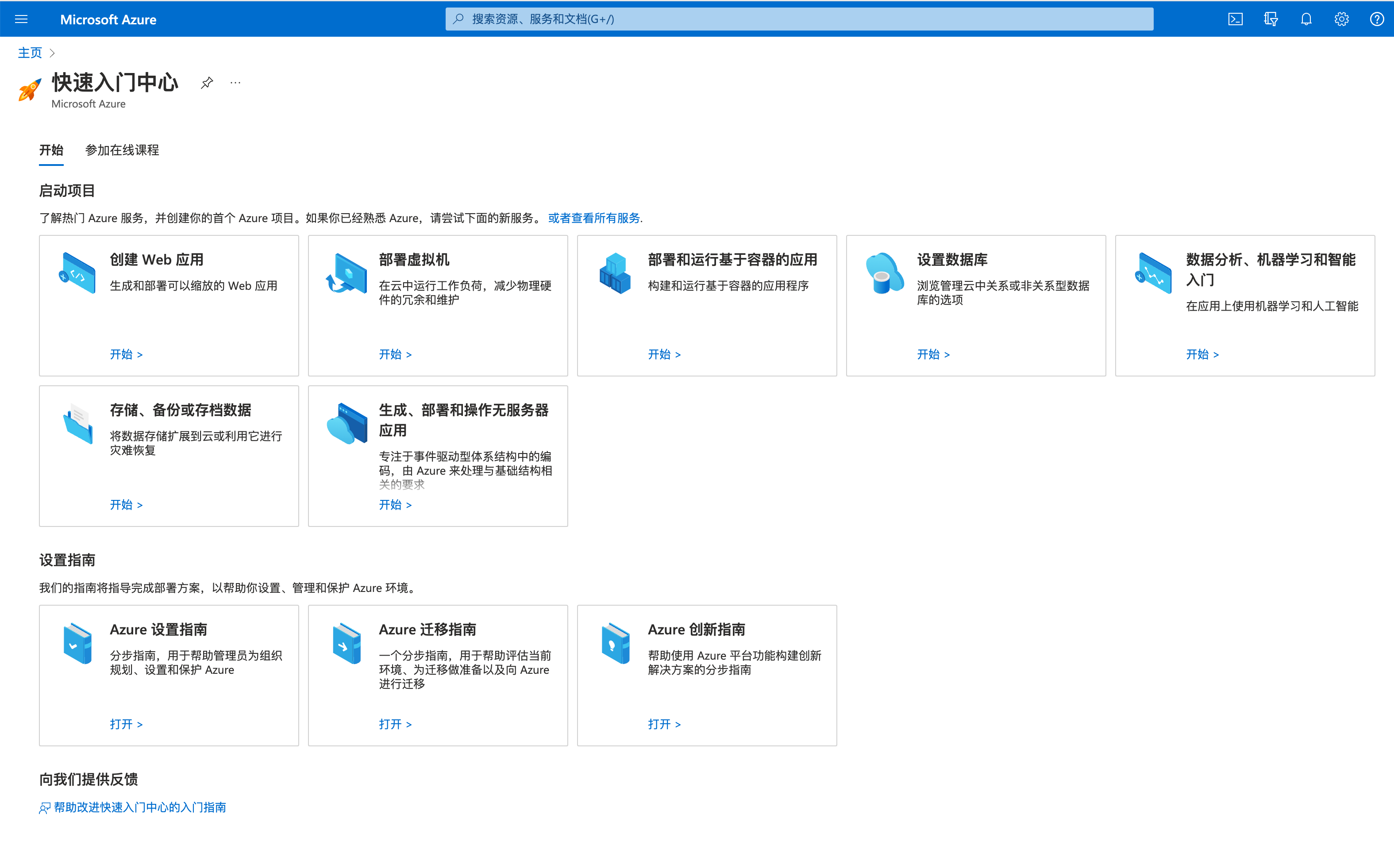
手動部署虛擬機
為了體驗一下Azure,我們先手動創建一個虛擬機,操作入口如下:

需要填寫一些配置信息,如主機名、區域、鏡像、網路埠等,按需要我打開了22/80/443埠。
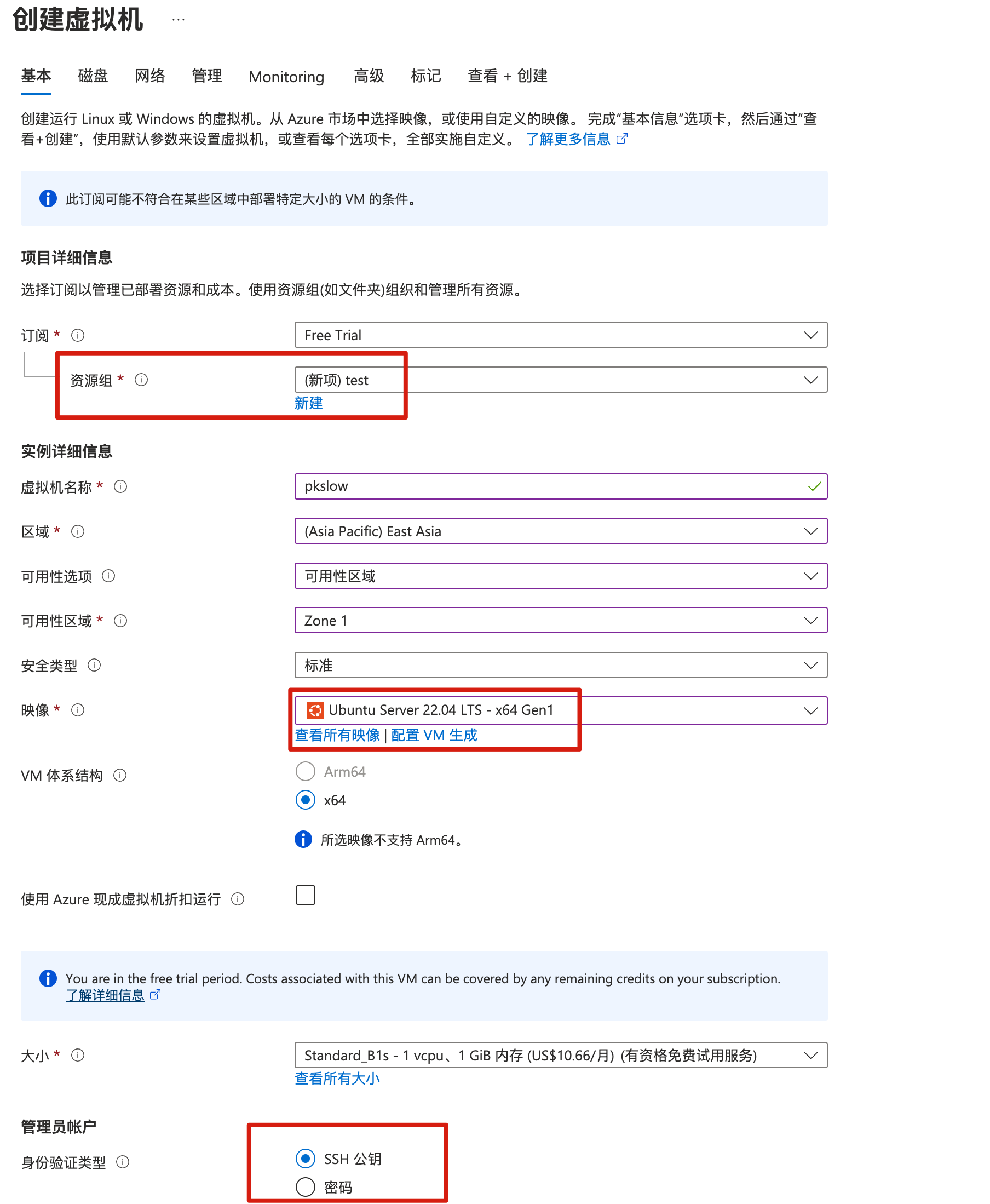
完成配置後,點擊創建,提示要下載密鑰對,必須要在創建的時候下載:
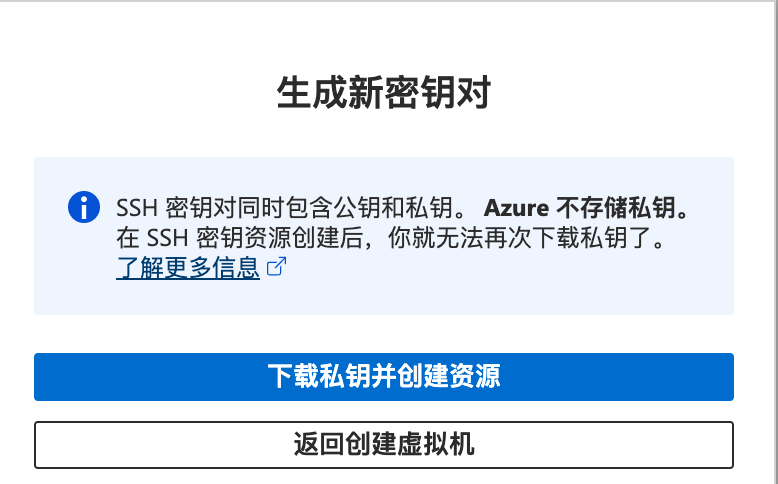
創建完資源後,可以在虛擬機列表查看:

根據用戶名和公網IP,我們可以ssh連接到伺服器。需要給密鑰文件修改許可權,太大是不行的,會報錯。
$ chmod 400 ~/Downloads/pksow-azure.pem
然後通過下麵命令連接:
$ ssh [email protected] -i ~/Downloads/pksow-azure.pem
Welcome to Ubuntu 22.04.1 LTS (GNU/Linux 5.15.0-1030-azure x86_64)
* Documentation: https://help.ubuntu.com
* Management: https://landscape.canonical.com
* Support: https://ubuntu.com/advantage
System load: 0.01513671875 Processes: 109
Usage of /: 4.9% of 28.89GB Users logged in: 0
Memory usage: 31% IPv4 address for eth0: 10.0.0.4
Swap usage: 0%
0 updates can be applied immediately.
The programs included with the Ubuntu system are free software;
the exact distribution terms for each program are described in the
individual files in /usr/share/doc/*/copyright.
Ubuntu comes with ABSOLUTELY NO WARRANTY, to the extent permitted by
applicable law.
To run a command as administrator (user "root"), use "sudo <command>".
See "man sudo_root" for details.
azureuser@pkslow:~$ free
total used free shared buff/cache available
Mem: 928460 261816 288932 4140 377712 533872
Swap: 0 0 0
azureuser@pkslow:~$ df -h
Filesystem Size Used Avail Use% Mounted on
/dev/root 29G 1.5G 28G 5% /
tmpfs 454M 0 454M 0% /dev/shm
tmpfs 182M 1.1M 181M 1% /run
tmpfs 5.0M 0 5.0M 0% /run/lock
/dev/sda15 105M 5.3M 100M 5% /boot/efi
/dev/sdb1 3.9G 28K 3.7G 1% /mnt
tmpfs 91M 4.0K 91M 1% /run/user/1000
通過azure-cli創建虛擬機
安裝azure-cli
我的電腦是MacOS,安裝如下:
$ brew update-reset
$ brew install azure-cli
$ which az
/usr/local/bin/az
$ az version
{
"azure-cli": "2.44.1",
"azure-cli-core": "2.44.1",
"azure-cli-telemetry": "1.0.8",
"extensions": {}
}
其它系統請參考: https://learn.microsoft.com/en-us/cli/azure/install-azure-cli
許可權
通過命令行操作Azure的資源,必然是需要許可權的,我們可以通過密碼,還可以通過Service Principal等方式來登陸。我們主要使用Service Principal的方式來授權。因此我們先在Portal上創建。
在左側菜單選擇Azure Active Directory,選擇應用註冊,點擊新註冊:

註冊應用程式:

添加密碼:
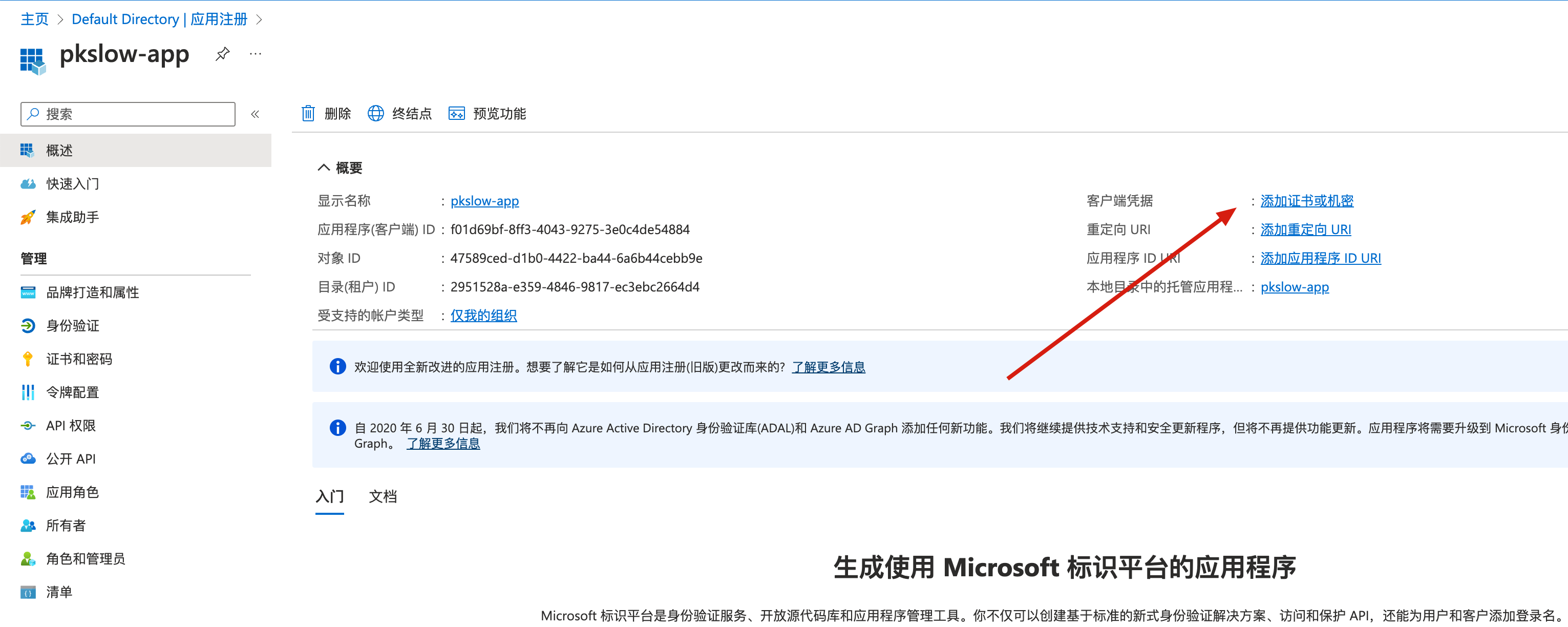
設置說明和時長:

創建完後要馬上記下密碼,後面無法再獲取密碼值:

查看租戶
需要查看租戶ID,或創建租戶:
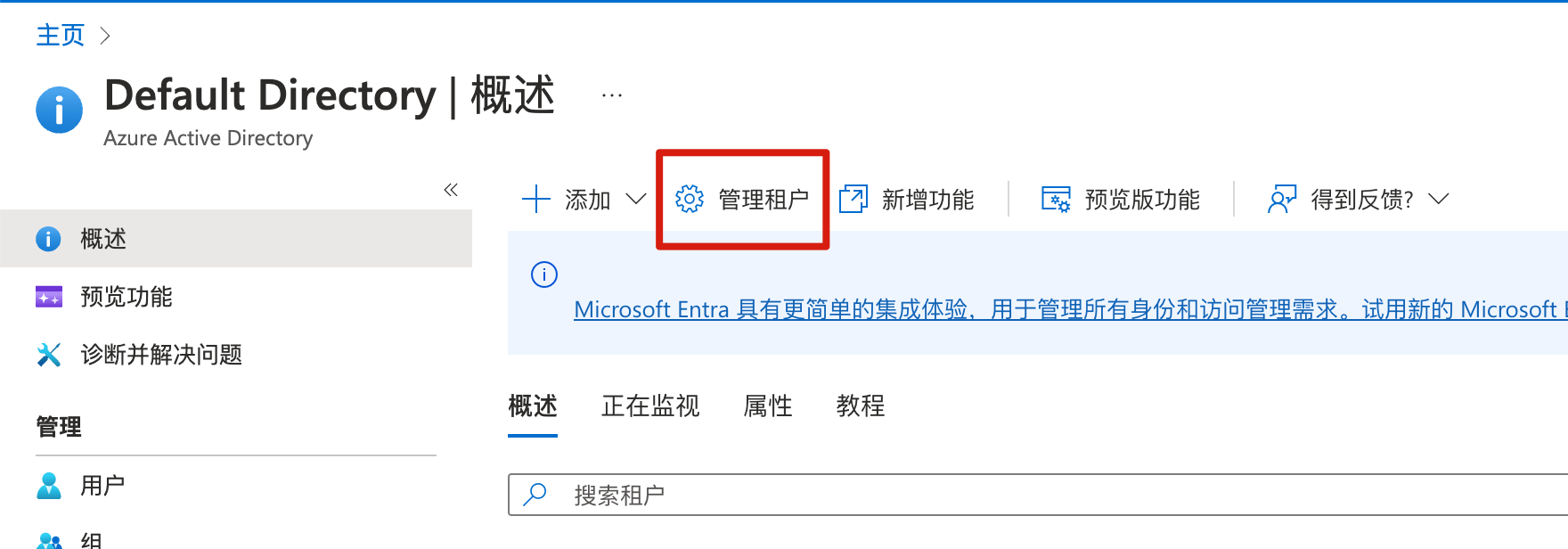
分配角色
到訂閱管理界面: Subscriptions page in Azure portal,查看訂閱列表:
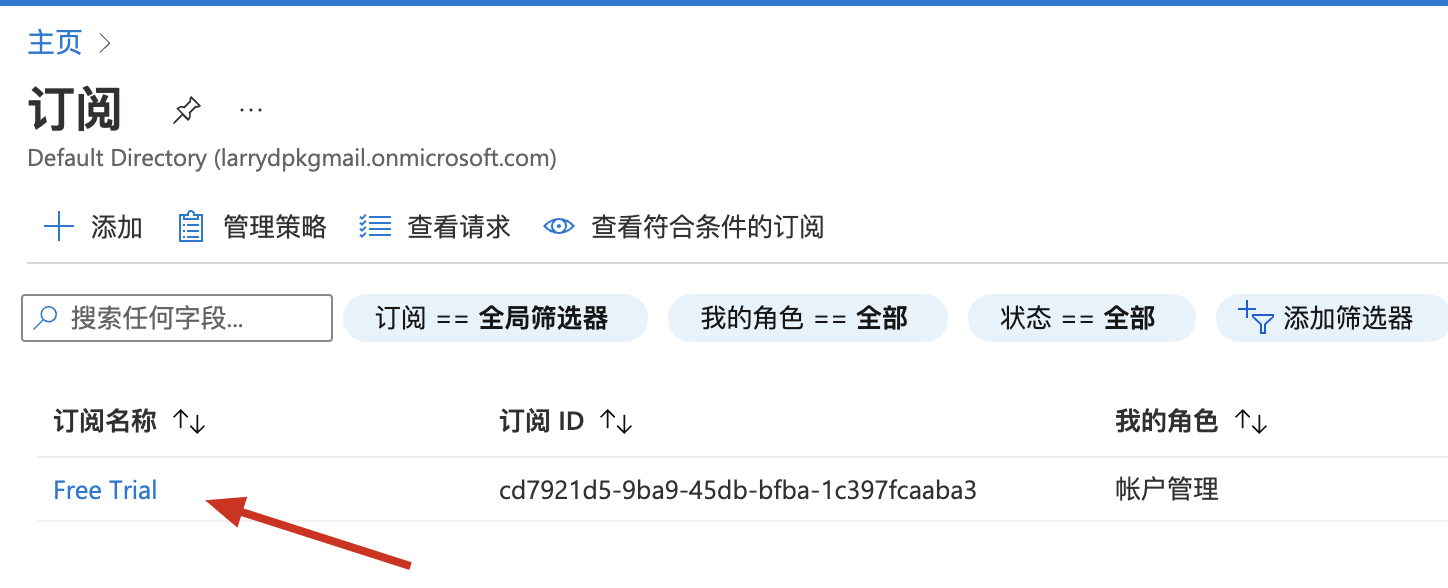
點進去後,可以管理訪問控制:

把之前創建的Service Principal加進來,分配特定角色:

選擇對應的Service Principal:

命令行登陸
完成以上操作後,就可以通過命令行來登陸Azure了:
$ az login --service-principal -u f01d69bf-8ff3-4043-9275-3e0c4de54884 -p B0N8Q~PQu6hTJkBTS5xxxxxxxx******** --tenant 2951528a-e359-4846-9817-ec3ebc2664d4
[
{
"cloudName": "AzureCloud",
"homeTenantId": "2951528a-e359-4846-9817-ec3ebc2664d4",
"id": "cd7921d5-9ba9-45db-bfba-1c397fcaaba3",
"isDefault": true,
"managedByTenants": [],
"name": "Free Trial",
"state": "Enabled",
"tenantId": "2951528a-e359-4846-9817-ec3ebc2664d4",
"user": {
"name": "f01d69bf-8ff3-4043-9275-3e0c4de54884",
"type": "servicePrincipal"
}
}
]
-u是註冊應用的ID;
-p就是之前要記下的密碼;
--tenant就是租戶ID;
查詢之前創建的VM,成功:
$ az vm list -g test --output table
Name ResourceGroup Location Zones
------ --------------- ---------- -------
pkslow test eastasia 1
創建vm
通過命令行創建vm如下:
$ az vm create --resource-group 'test' --name 'pkslow2' --image 'canonical:0001-com-ubuntu-server-jammy:22_04-lts:22.04.202301100' --admin-username 'larry' --admin-password 'Pa!!!ss123' --location 'eastasia'
{
"fqdns": "",
"id": "/subscriptions/cd7921d5-9ba9-45db-bfba-1c397fcaaba3/resourceGroups/test/providers/Microsoft.Compute/virtualMachines/pkslow2",
"location": "eastasia",
"macAddress": "60-45-BD-57-30-C1",
"powerState": "VM running",
"privateIpAddress": "10.0.0.5",
"publicIpAddress": "20.187.85.53",
"resourceGroup": "test",
"zones": ""
}
查詢後成功創建,已經有2台虛擬機在運行:
$ az vm list -g test --output table
Name ResourceGroup Location Zones
------- --------------- ---------- -------
pkslow test eastasia 1
pkslow2 test eastasia
用Terraform創建vm
許可權環境變數設置
當我們使用Terraform來操作Azure時,同樣也是需要許可權的,配置以下環境變數即可。這些值在前面的內容已經講過了。
export ARM_SUBSCRIPTION_ID="<azure_subscription_id>"
export ARM_TENANT_ID="<azure_subscription_tenant_id>"
export ARM_CLIENT_ID="<service_principal_appid>"
export ARM_CLIENT_SECRET="<service_principal_password>"
插件和版本
配置Terraform和插件的版本:
terraform {
required_version = ">= 1.1.3"
required_providers {
azurerm = {
source = "hashicorp/azurerm"
version = "3.38.0"
}
}
}
創建vm
通過azurerm_virtual_machine來創建VM資源:
provider "azurerm" {
features {}
}
variable "prefix" {
default = "pkslow-azure"
}
resource "azurerm_resource_group" "example" {
name = "${var.prefix}-resources"
location = "West Europe"
}
resource "azurerm_virtual_network" "main" {
name = "${var.prefix}-network"
address_space = ["10.0.0.0/16"]
location = azurerm_resource_group.example.location
resource_group_name = azurerm_resource_group.example.name
}
resource "azurerm_subnet" "internal" {
name = "internal"
resource_group_name = azurerm_resource_group.example.name
virtual_network_name = azurerm_virtual_network.main.name
address_prefixes = ["10.0.2.0/24"]
}
resource "azurerm_network_interface" "main" {
name = "${var.prefix}-nic"
location = azurerm_resource_group.example.location
resource_group_name = azurerm_resource_group.example.name
ip_configuration {
name = "testconfiguration1"
subnet_id = azurerm_subnet.internal.id
private_ip_address_allocation = "Dynamic"
}
}
resource "azurerm_virtual_machine" "main" {
name = "${var.prefix}-vm"
location = azurerm_resource_group.example.location
resource_group_name = azurerm_resource_group.example.name
network_interface_ids = [azurerm_network_interface.main.id]
vm_size = "Standard_DS1_v2"
# Uncomment this line to delete the OS disk automatically when deleting the VM
# delete_os_disk_on_termination = true
# Uncomment this line to delete the data disks automatically when deleting the VM
# delete_data_disks_on_termination = true
storage_image_reference {
publisher = "Canonical"
offer = "0001-com-ubuntu-server-jammy"
sku = "22_04-lts"
version = "22.04.202301100"
}
storage_os_disk {
name = "myosdisk1"
caching = "ReadWrite"
create_option = "FromImage"
managed_disk_type = "Standard_LRS"
}
os_profile {
computer_name = "hostname"
admin_username = "larry"
admin_password = "Password1234!"
}
os_profile_linux_config {
disable_password_authentication = false
}
tags = {
environment = "staging"
}
}
然後我們執行初始化,會下載Azure的Terraform插件:
$ terraform init
Initializing the backend...
Initializing provider plugins...
- Finding hashicorp/azurerm versions matching "3.38.0"...
- Installing hashicorp/azurerm v3.38.0...
- Installed hashicorp/azurerm v3.38.0 (signed by HashiCorp)
Terraform has created a lock file .terraform.lock.hcl to record the provider
selections it made above. Include this file in your version control repository
so that Terraform can guarantee to make the same selections by default when
you run "terraform init" in the future.
Terraform has been successfully initialized!
You may now begin working with Terraform. Try running "terraform plan" to see
any changes that are required for your infrastructure. All Terraform commands
should now work.
If you ever set or change modules or backend configuration for Terraform,
rerun this command to reinitialize your working directory. If you forget, other
commands will detect it and remind you to do so if necessary.
查看plan,看看會生成什麼資源:
$ terraform plan
Terraform used the selected providers to generate the following execution plan. Resource actions are indicated with the following symbols:
+ create
Terraform will perform the following actions:
# azurerm_network_interface.main will be created
+ resource "azurerm_network_interface" "main" {
+ applied_dns_servers = (known after apply)
+ dns_servers = (known after apply)
+ enable_accelerated_networking = false
+ enable_ip_forwarding = false
+ id = (known after apply)
+ internal_dns_name_label = (known after apply)
+ internal_domain_name_suffix = (known after apply)
+ location = "westeurope"
+ mac_address = (known after apply)
+ name = "pkslow-azure-nic"
+ private_ip_address = (known after apply)
+ private_ip_addresses = (known after apply)
+ resource_group_name = "pkslow-azure-resources"
+ virtual_machine_id = (known after apply)
+ ip_configuration {
+ gateway_load_balancer_frontend_ip_configuration_id = (known after apply)
+ name = "testconfiguration1"
+ primary = (known after apply)
+ private_ip_address = (known after apply)
+ private_ip_address_allocation = "Dynamic"
+ private_ip_address_version = "IPv4"
+ subnet_id = (known after apply)
}
}
# azurerm_resource_group.example will be created
+ resource "azurerm_resource_group" "example" {
+ id = (known after apply)
+ location = "westeurope"
+ name = "pkslow-azure-resources"
}
# azurerm_subnet.internal will be created
+ resource "azurerm_subnet" "internal" {
+ address_prefixes = [
+ "10.0.2.0/24",
]
+ enforce_private_link_endpoint_network_policies = (known after apply)
+ enforce_private_link_service_network_policies = (known after apply)
+ id = (known after apply)
+ name = "internal"
+ private_endpoint_network_policies_enabled = (known after apply)
+ private_link_service_network_policies_enabled = (known after apply)
+ resource_group_name = "pkslow-azure-resources"
+ virtual_network_name = "pkslow-azure-network"
}
# azurerm_virtual_machine.main will be created
+ resource "azurerm_virtual_machine" "main" {
+ availability_set_id = (known after apply)
+ delete_data_disks_on_termination = false
+ delete_os_disk_on_termination = false
+ id = (known after apply)
+ license_type = (known after apply)
+ location = "westeurope"
+ name = "pkslow-azure-vm"
+ network_interface_ids = (known after apply)
+ resource_group_name = "pkslow-azure-resources"
+ tags = {
+ "environment" = "staging"
}
+ vm_size = "Standard_DS1_v2"
+ identity {
+ identity_ids = (known after apply)
+ principal_id = (known after apply)
+ type = (known after apply)
}
+ os_profile {
+ admin_password = (sensitive value)
+ admin_username = "larry"
+ computer_name = "hostname"
+ custom_data = (known after apply)
}
+ os_profile_linux_config {
+ disable_password_authentication = false
}
+ storage_data_disk {
+ caching = (known after apply)
+ create_option = (known after apply)
+ disk_size_gb = (known after apply)
+ lun = (known after apply)
+ managed_disk_id = (known after apply)
+ managed_disk_type = (known after apply)
+ name = (known after apply)
+ vhd_uri = (known after apply)
+ write_accelerator_enabled = (known after apply)
}
+ storage_image_reference {
+ offer = "0001-com-ubuntu-server-jammy"
+ publisher = "Canonical"
+ sku = "22_04-lts"
+ version = "22.04.202301100"
}
+ storage_os_disk {
+ caching = "ReadWrite"
+ create_option = "FromImage"
+ disk_size_gb = (known after apply)
+ managed_disk_id = (known after apply)
+ managed_disk_type = "Standard_LRS"
+ name = "myosdisk1"
+ os_type = (known after apply)
+ write_accelerator_enabled = false
}
}
# azurerm_virtual_network.main will be created
+ resource "azurerm_virtual_network" "main" {
+ address_space = [
+ "10.0.0.0/16",
]
+ dns_servers = (known after apply)
+ guid = (known after apply)
+ id = (known after apply)
+ location = "westeurope"
+ name = "pkslow-azure-network"
+ resource_group_name = "pkslow-azure-resources"
+ subnet = (known after apply)
}
Plan: 5 to add, 0 to change, 0 to destroy.
─────────────────────────────────────────────────────────────────────────────────────────────────────────────────────────────────────────────────────────────────────────────────
Note: You didn't use the -out option to save this plan, so Terraform can't guarantee to take exactly these actions if you run "terraform apply" now.
直接apply,創建對應的資源:
$ terraform apply
Terraform used the selected providers to generate the following execution plan. Resource actions are indicated with the following symbols:
+ create
Terraform will perform the following actions:
# azurerm_network_interface.main will be created
+ resource "azurerm_network_interface" "main" {
+ applied_dns_servers = (known after apply)
+ dns_servers = (known after apply)
+ enable_accelerated_networking = false
+ enable_ip_forwarding = false
+ id = (known after apply)
+ internal_dns_name_label = (known after apply)
+ internal_domain_name_suffix = (known after apply)
+ location = "westeurope"
+ mac_address = (known after apply)
+ name = "pkslow-azure-nic"
+ private_ip_address = (known after apply)
+ private_ip_addresses = (known after apply)
+ resource_group_name = "pkslow-azure-resources"
+ virtual_machine_id = (known after apply)
+ ip_configuration {
+ gateway_load_balancer_frontend_ip_configuration_id = (known after apply)
+ name = "testconfiguration1"
+ primary = (known after apply)
+ private_ip_address = (known after apply)
+ private_ip_address_allocation = "Dynamic"
+ private_ip_address_version = "IPv4"
+ subnet_id = (known after apply)
}
}
# azurerm_resource_group.example will be created
+ resource "azurerm_resource_group" "example" {
+ id = (known after apply)
+ location = "westeurope"
+ name = "pkslow-azure-resources"
}
# azurerm_subnet.internal will be created
+ resource "azurerm_subnet" "internal" {
+ address_prefixes = [
+ "10.0.2.0/24",
]
+ enforce_private_link_endpoint_network_policies = (known after apply)
+ enforce_private_link_service_network_policies = (known after apply)
+ id = (known after apply)
+ name = "internal"
+ private_endpoint_network_policies_enabled = (known after apply)
+ private_link_service_network_policies_enabled = (known after apply)
+ resource_group_name = "pkslow-azure-resources"
+ virtual_network_name = "pkslow-azure-network"
}
# azurerm_virtual_machine.main will be created
+ resource "azurerm_virtual_machine" "main" {
+ availability_set_id = (known after apply)
+ delete_data_disks_on_termination = false
+ delete_os_disk_on_termination = false
+ id = (known after apply)
+ license_type = (known after apply)
+ location = "westeurope"
+ name = "pkslow-azure-vm"
+ network_interface_ids = (known after apply)
+ resource_group_name = "pkslow-azure-resources"
+ tags = {
+ "environment" = "staging"
}
+ vm_size = "Standard_DS1_v2"
+ identity {
+ identity_ids = (known after apply)
+ principal_id = (known after apply)
+ type = (known after apply)
}
+ os_profile {
+ admin_password = (sensitive value)
+ admin_username = "larry"
+ computer_name = "hostname"
+ custom_data = (known after apply)
}
+ os_profile_linux_config {
+ disable_password_authentication = false
}
+ storage_data_disk {
+ caching = (known after apply)
+ create_option = (known after apply)
+ disk_size_gb = (known after apply)
+ lun = (known after apply)
+ managed_disk_id = (known after apply)
+ managed_disk_type = (known after apply)
+ name = (known after apply)
+ vhd_uri = (known after apply)
+ write_accelerator_enabled = (known after apply)
}
+ storage_image_reference {
+ offer = "0001-com-ubuntu-server-jammy"
+ publisher = "Canonical"
+ sku = "22_04-lts"
+ version = "22.04.202301100"
}
+ storage_os_disk {
+ caching = "ReadWrite"
+ create_option = "FromImage"
+ disk_size_gb = (known after apply)
+ managed_disk_id = (known after apply)
+ managed_disk_type = "Standard_LRS"
+ name = "myosdisk1"
+ os_type = (known after apply)
+ write_accelerator_enabled = false
}
}
# azurerm_virtual_network.main will be created
+ resource "azurerm_virtual_network" "main" {
+ address_space = [
+ "10.0.0.0/16",
]
+ dns_servers = (known after apply)
+ guid = (known after apply)
+ id = (known after apply)
+ location = "westeurope"
+ name = "pkslow-azure-network"
+ resource_group_name = "pkslow-azure-resources"
+ subnet = (known after apply)
}
Plan: 5 to add, 0 to change, 0 to destroy.
Do you want to perform these actions?
Terraform will perform the actions described above.
Only 'yes' will be accepted to approve.
Enter a value: yes
azurerm_resource_group.example: Creating...
azurerm_resource_group.example: Creation complete after 9s [id=/subscriptions/cd7921d5-9ba9-45db-bfba-1c397fcaaba3/resourceGroups/pkslow-azure-resources]
azurerm_virtual_network.main: Creating...
azurerm_virtual_network.main: Still creating... [10s elapsed]
azurerm_virtual_network.main: Creation complete after 17s [id=/subscriptions/cd7921d5-9ba9-45db-bfba-1c397fcaaba3/resourceGroups/pkslow-azure-resources/providers/Microsoft.Network/virtualNetworks/pkslow-azure-network]
azurerm_subnet.internal: Creating...
azurerm_subnet.internal: Still creating... [10s elapsed]
azurerm_subnet.internal: Creation complete after 11s [id=/subscriptions/cd7921d5-9ba9-45db-bfba-1c397fcaaba3/resourceGroups/pkslow-azure-resources/providers/Microsoft.Network/virtualNetworks/pkslow-azure-network/subnets/internal]
azurerm_network_interface.main: Creating...
azurerm_network_interface.main: Still creating... [10s elapsed]
azurerm_network_interface.main: Creation complete after 10s [id=/subscriptions/cd7921d5-9ba9-45db-bfba-1c397fcaaba3/resourceGroups/pkslow-azure-resources/providers/Microsoft.Network/networkInterfaces/pkslow-azure-nic]
azurerm_virtual_machine.main: Creating...
azurerm_virtual_machine.main: Still creating... [10s elapsed]
azurerm_virtual_machine.main: Still creating... [20s elapsed]
azurerm_virtual_machine.main: Still creating... [30s elapsed]
azurerm_virtual_machine.main: Still creating... [40s elapsed]
azurerm_virtual_machine.main: Still creating... [50s elapsed]
azurerm_virtual_machine.main: Still creating... [1m0s elapsed]
azurerm_virtual_machine.main: Creation complete after 1m0s [id=/subscriptions/cd7921d5-9ba9-45db-bfba-1c397fcaaba3/resourceGroups/pkslow-azure-resources/providers/Microsoft.Compute/virtualMachines/pkslow-azure-vm]
Apply complete! Resources: 5 added, 0 changed, 0 destroyed.
查看所有資源,選擇資源組pkslow-azure-resources下麵的,已經成功創建:

使用完成後,通過下麵命令刪除:
terraform destroy
部署Azure Kubernetes集群
通過Auzre CLI部署
創建資源組
Azure資源組是用於部署和管理Azure資源的邏輯組。創建資源時,系統會提示你指定一個位置。該位置主要用於:
(1)資源組元數據的存儲位置;
(2)在創建資源期間未指定另一個區域時,資源在Azure中的運行位置。
我們通過以下命令來創建資源組:
$ az group create --name pkslow-aks --location eastasia
{
"id": "/subscriptions/cd7921d5-9ba9-45db-bfba-1c397fcaaba3/resourceGroups/pkslow-aks",
"location": "eastasia",
"managedBy": null,
"name": "pkslow-aks",
"properties": {
"provisioningState": "Succeeded"
},
"tags": null,
"type": "Microsoft.Resources/resourceGroups"
}
創建AKS
通過下麵的命令創建AKS:
az aks create -g pkslow-aks -n pkslow --enable-managed-identity --node-count 1 --enable-addons monitoring --enable-msi-auth-for-monitoring --generate-ssh-keys
創建完成後會輸出很大的Json日誌,我們直接來查看一下是否正確生成:
$ az aks list --output table
Name Location ResourceGroup KubernetesVersion CurrentKubernetesVersion ProvisioningState Fqdn
------ ---------- --------------- ------------------- -------------------------- ------------------- --------------------------------------------------------
pkslow eastasia pkslow-aks 1.24.6 1.24.6 Succeeded pkslow-pkslow-aks-cd7921-725c7247.hcp.eastasia.azmk8s.io
連接到AKS
需要有kubectl命令,沒有的就安裝一下:
az aks install-cli
連接集群需要認證,要獲取一下驗證配置:
$ az aks get-credentials --resource-group pkslow-aks --name pkslow
Merged "pkslow" as current context in /Users/larry/.kube/config
成功後就可以連接並操作了:
$ kubectl get node
NAME STATUS ROLES AGE VERSION
aks-nodepool1-29201873-vmss000000 Ready agent 8m45s v1.24.6
$ kubectl get ns
NAME STATUS AGE
default Active 9m33s
kube-node-lease Active 9m35s
kube-public Active 9m35s
kube-system Active 9m35s
$ kubectl get pod -n kube-system
NAME READY STATUS RESTARTS AGE
ama-logs-lhlkb 3/3 Running 0 9m8s
ama-logs-rs-6cf9546595-rdmh9 2/2 Running 0 9m26s
azure-ip-masq-agent-nppvd 1/1 Running 0 9m8s
cloud-node-manager-bd4c2 1/1 Running 0 9m8s
coredns-59b6bf8b4f-lrzpp 1/1 Running 0 9m26s
coredns-59b6bf8b4f-zbbkm 1/1 Running 0 7m56s
coredns-autoscaler-5655d66f64-5946c 1/1 Running 0 9m26s
csi-azuredisk-node-9rpvd 3/3 Running 0 9m8s
csi-azurefile-node-hvxhc 3/3 Running 0 9m8s
konnectivity-agent-95ff8bbd-fwkds 1/1 Running 0 9m26s
konnectivity-agent-95ff8bbd-qg9vx 1/1 Running 0 9m26s
kube-proxy-c5crz 1/1 Running 0 9m8s
metrics-server-7dd74d8758-ms8h9 2/2 Running 0 7m50s
metrics-server-7dd74d8758-nxq9t 2/2 Running 0 7m50s
部署測試應用
為了方便,我們直接使用官網的示例來測試一下。創建文件azure-vote.yaml,內容如下:
apiVersion: apps/v1
kind: Deployment
metadata:
name: azure-vote-back
spec:
replicas: 1
selector:
matchLabels:
app: azure-vote-back
template:
metadata:
labels:
app: azure-vote-back
spec:
nodeSelector:
"kubernetes.io/os": linux
containers:
- name: azure-vote-back
image: mcr.microsoft.com/oss/bitnami/redis:6.0.8
env:
- name: ALLOW_EMPTY_PASSWORD
value: "yes"
resources:
requests:
cpu: 100m
memory: 128Mi
limits:
cpu: 250m
memory: 256Mi
ports:
- containerPort: 6379
name: redis
---
apiVersion: v1
kind: Service
metadata:
name: azure-vote-back
spec:
ports:
- port: 6379
selector:
app: azure-vote-back
---
apiVersion: apps/v1
kind: Deployment
metadata:
name: azure-vote-front
spec:
replicas: 1
selector:
matchLabels:
app: azure-vote-front
template:
metadata:
labels:
app: azure-vote-front
spec:
nodeSelector:
"kubernetes.io/os": linux
containers:
- name: azure-vote-front
image: mcr.microsoft.com/azuredocs/azure-vote-front:v1
resources:
requests:
cpu: 100m
memory: 128Mi
limits:
cpu: 250m
memory: 256Mi
ports:
- containerPort: 80
env:
- name: REDIS
value: "azure-vote-back"
---
apiVersion: v1
kind: Service
metadata:
name: azure-vote-front
spec:
type: LoadBalancer
ports:
- port: 80
selector:
app: azure-vote-front
然後執行以下命令:
$ kubectl apply -f azure-vote.yaml
deployment.apps/azure-vote-back created
service/azure-vote-back created
deployment.apps/azure-vote-front created
service/azure-vote-front created
成功後查看對應資源:
$ kubectl get svc
NAME TYPE CLUSTER-IP EXTERNAL-IP PORT(S) AGE
azure-vote-back ClusterIP 10.0.156.161 <none> 6379/TCP 112s
azure-vote-front LoadBalancer 10.0.29.217 20.239.124.1 80:30289/TCP 112s
kubernetes ClusterIP 10.0.0.1 <none> 443/TCP 21m
$ kubectl get deployment
NAME READY UP-TO-DATE AVAILABLE AGE
azure-vote-back 1/1 1 1 2m1s
azure-vote-front 1/1 1 1 2m1s
$ kubectl get pod
NAME READY STATUS RESTARTS AGE
azure-vote-back-7cd69cc96f-gqm7r 1/1 Running 0 2m7s
azure-vote-front-7c95676c68-jtkqz 1/1 Running 0 2m7s
已經成功創建。
看front那有external IP,通過它直接在瀏覽器訪問如下:
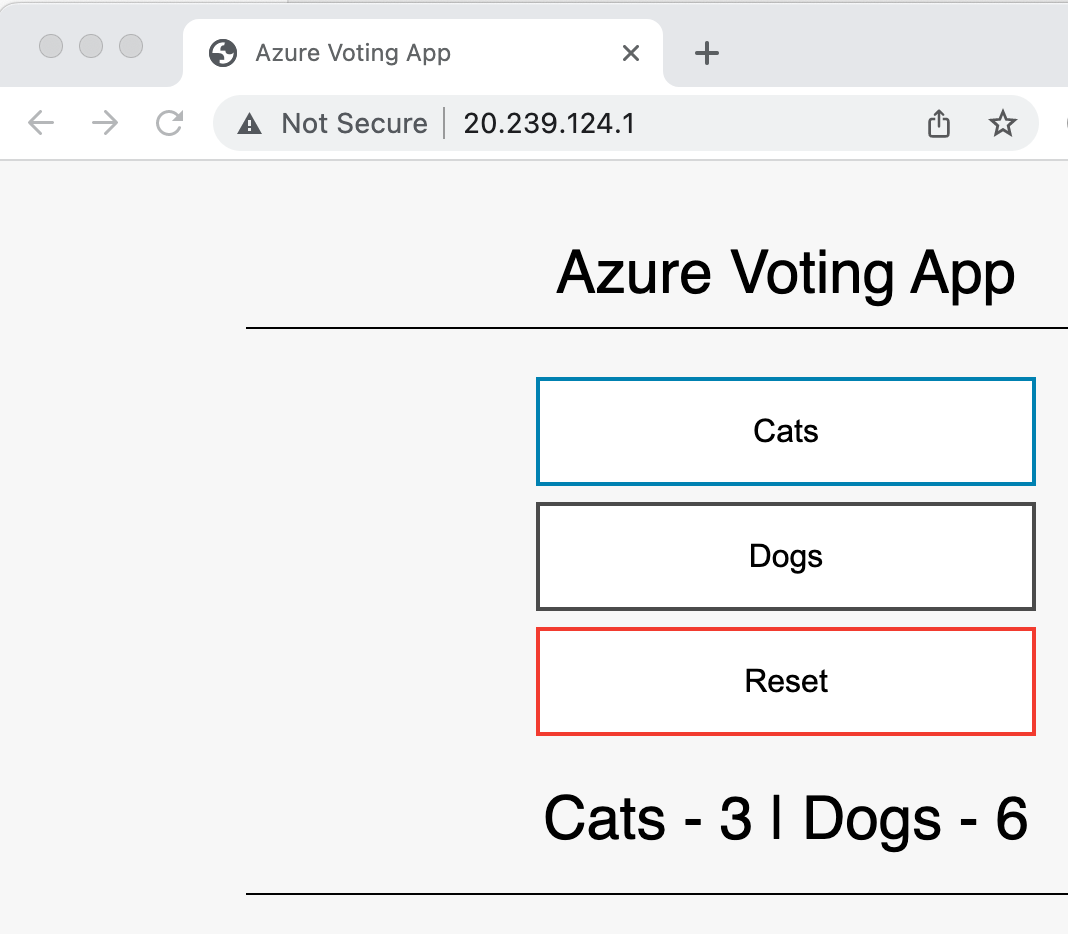
應用已經成功部署並訪問了。
刪除資源組
如果完成測試,不再使用,可以整個資源組一起刪除:
az group delete --name pkslow-aks --yes --no-wait
通過Terraform部署
配置插件和版本
terraform {
required_version = ">= 1.1.3"
required_providers {
azurerm = {
source = "hashicorp/azurerm"
version = "3.38.0"
}
random = {
source = "hashicorp/random"
version = "= 3.1.0"
}
}
}
變數設置
給Terraform設置一些要用到的變數:
variable "agent_count" {
default = 1
}
# The following two variable declarations are placeholder references.
# Set the values for these variable in terraform.tfvars
variable "aks_service_principal_app_id" {
default = ""
}
variable "aks_service_principal_client_secret" {
default = ""
}
variable "cluster_name" {
default = "pkslow-k8s"
}
variable "dns_prefix" {
default = "pkslow"
}
# Refer to https://azure.microsoft.com/global-infrastructure/services/?products=monitor for available Log Analytics regions.
variable "log_analytics_workspace_location" {
default = "eastus"
}
variable "log_analytics_workspace_name" {
default = "testLogAnalyticsWorkspaceName"
}
# Refer to https://azure.microsoft.com/pricing/details/monitor/ for Log Analytics pricing
variable "log_analytics_workspace_sku" {
default = "PerGB2018"
}
variable "resource_group_location" {
default = "eastus"
description = "Location of the resource group."
}
variable "resource_group_name_prefix" {
default = "rg"
description = "Prefix of the resource group name that's combined with a random ID so name is unique in your Azure subscription."
}
variable "ssh_public_key" {
default = "~/.ssh/id_rsa.pub"
}
agent_count應該設置合理,這裡設成1是因為我的賬號是免費的,有限制。
輸出結果
當Terraform執行完,會有一些結果,我們可以把一些值輸出以便使用:
output "client_certificate" {
value = azurerm_kubernetes_cluster.k8s.kube_config[0].client_certificate
sensitive = true
}
output "client_key" {
value = azurerm_kubernetes_cluster.k8s.kube_config[0].client_key
sensitive = true
}
output "cluster_ca_certificate" {
value = azurerm_kubernetes_cluster.k8s.kube_config[0].cluster_ca_certificate
sensitive = true
}
output "cluster_password" {
value = azurerm_kubernetes_cluster.k8s.kube_config[0].password
sensitive = true
}
output "cluster_username" {
value = azurerm_kubernetes_cluster.k8s.kube_config[0].username
sensitive = true
}
output "host" {
value = azurerm_kubernetes_cluster.k8s.kube_config[0].host
sensitive = true
}
output "kube_config" {
value = azurerm_kubernetes_cluster.k8s.kube_config_raw
sensitive = true
}
output "resource_group_name" {
value = azurerm_resource_group.rg.name
}
main.tf創建AKS
通過azurerm_kubernetes_cluster創建AKS:
provider "azurerm" {
features {}
}
# Generate random resource group name
resource "random_pet" "rg_name" {
prefix = var.resource_group_name_prefix
}
resource "azurerm_resource_group" "rg" {
location = var.resource_group_location
name = random_pet.rg_name.id
}
resource "random_id" "log_analytics_workspace_name_suffix" {
byte_length = 8
}
resource "azurerm_log_analytics_workspace" "test" {
location = var.log_analytics_workspace_location
# The WorkSpace name has to be unique across the whole of azure;
# not just the current subscription/tenant.
name = "${var.log_analytics_workspace_name}-${random_id.log_analytics_workspace_name_suffix.dec}"
resource_group_name = azurerm_resource_group.rg.name
sku = var.log_analytics_workspace_sku
}
resource "azurerm_log_analytics_solution" "test" {
location = azurerm_log_analytics_workspace.test.location
resource_group_name = azurerm_resource_group.rg.name
solution_name = "ContainerInsights"
workspace_name = azurerm_log_analytics_workspace.test.name
workspace_resource_id = azurerm_log_analytics_workspace.test.id
plan {
product = "OMSGallery/ContainerInsights"
publisher = "Microsoft"
}
}
resource "azurerm_kubernetes_cluster" "k8s" {
location = azurerm_resource_group.rg.location
name = var.cluster_name
resource_group_name = azurerm_resource_group.rg.name
dns_prefix = var.dns_prefix
tags = {
Environment = "Development"
}
default_node_pool {
name = "agentpool"
vm_size = "Standard_D2_v2"
node_count = var.agent_count
}
linux_profile {
admin_username = "ubuntu"
ssh_key {
key_data = file(var.ssh_public_key)
}
}
network_profile {
network_plugin = "kubenet"
load_balancer_sku = "standard"
}
service_principal {
client_id = var.aks_service_principal_app_id
client_secret = var.aks_service_principal_client_secret
}
}
執行
準備好文件後,先初始化,下載插件:
$ terraform init
Initializing the backend...
Initializing provider plugins...
- Finding hashicorp/random versions matching "3.1.0"...
- Finding hashicorp/azurerm versions matching "3.38.0"...
- Installing hashicorp/random v3.1.0...
- Installed hashicorp/random v3.1.0 (unauthenticated)
- Installing hashicorp/azurerm v3.38.0...
- Installed hashicorp/azurerm v3.38.0 (signed by HashiCorp)
Terraform has created a lock file .terraform.lock.hcl to record the provider
selections it made above. Include this file in your version control repository
so that Terraform can guarantee to make the same selections by default when
you run "terraform init" in the future.
Terraform has been successfully initialized!
You may now begin working with Terraform. Try running "terraform plan" to see
any changes that are required for your infrastructure. All Terraform commands
should now work.
If you ever set or change modules or backend configuration for Terraform,
rerun this command to reinitialize your working directory. If you forget, other
commands will detect it and remind you to do so if necessary.
查看Terraform計劃,知道將要生成多少資源:
$ terraform plan -out main.tfplan -var="aks_service_principal_app_id=$ARM_CLIENT_ID" -var="aks_service_principal_client_secret=$ARM_CLIENT_SECRET"
沒有問題則執行變更:
$ terraform apply main.tfplan
Outputs:
client_certificate = <sensitive>
client_key = <sensitive>
cluster_ca_certificate = <sensitive>
cluster_password = <sensitive>
cluster_username = <sensitive>
host = <sensitive>
kube_config = <sensitive>
resource_group_name = "rg-harmless-tomcat"
連接AKS
把kube_config輸出,然後設置環境變數就可以通過kubectl連接了:
$ echo "$(terraform output kube_config)" > ./azurek8s
$ export KUBECONFIG=./azurek8s
$ kubectl get nodes
NAME STATUS ROLES AGE VERSION
aks-agentpool-45159290-vmss000000 Ready agent 9m20s v1.24.6
如果有問題,可以查看azurek8s文件是否正常。
創建PostgreSQL
通過Azure CLI創建Single Server
創建資源組和資料庫
先創建資源組:
az group create --name pkslow-sql --location eastasia --tag create-postgresql-server-and-firewall-rule
然後創建資料庫:
$ az postgres server create \
> --name pkslow-pg \
> --resource-group pkslow-sql \
> --location eastasia \
> --admin-user pguser \
> --admin-password 'Pa$$word' \
> --sku-name GP_Gen5_2
Checking the existence of the resource group 'pkslow-sql'...
Resource group 'pkslow-sql' exists ? : True
Creating postgres Server 'pkslow-pg' in group 'pkslow-sql'...
Your server 'pkslow-pg' is using sku 'GP_Gen5_2' (Paid Tier). Please refer to https://aka.ms/postgres-pricing for pricing details
Make a note of your password. If you forget, you would have to reset your password with 'az postgres server update -n pkslow-pg -g pkslow-sql -p <new-password>'.
{
"additionalProperties": {},
"administratorLogin": "pguser",
"byokEnforcement": "Disabled",
"connectionString": "postgres://pguser%40pkslow-pg:[email protected]/postgres?sslmode=require",
"earliestRestoreDate": "2023-01-15T03:24:18.440000+00:00",
"fullyQualifiedDomainName": "pkslow-pg.postgres.database.azure.com",
"id": "/subscriptions/cd7921d5-9ba9-45db-bfba-1c397fcaaba3/resourceGroups/pkslow-sql/providers/Microsoft.DBforPostgreSQL/servers/pkslow-pg",
"identity": null,
"infrastructureEncryption": "Disabled",
"location": "eastasia",
"masterServerId": "",
"minimalTlsVersion": "TLSEnforcementDisabled",
"name": "pkslow-pg",
"password": "Pa$$word",
"privateEndpointConnections": [],
"publicNetworkAccess": "Enabled",
"replicaCapacity": 5,
"replicationRole": "None",
"resourceGroup": "pkslow-sql",
"sku": {
"additionalProperties": {},
"capacity": 2,
"family": "Gen5",
"name": "GP_Gen5_2",
"size": null,
"tier": "GeneralPurpose"
},
"sslEnforcement": "Enabled",
"storageProfile": {
"additionalProperties": {},
"backupRetentionDays": 7,
"geoRedundantBackup": "Disabled",
"storageAutogrow": "Enabled",
"storageMb": 5120
},
"tags": null,
"type": "Microsoft.DBforPostgreSQL/servers",
"userVisibleState": "Ready",
"version": "11"
}
創建成功後,會列印很多有用的信息,如連接信息。
也可以在以後查看:
az postgres server show --resource-group pkslow-sql --name pkslow-pg
禁用SSL
創建完成後還可以更新一些配置,如我們禁用SSL:
az postgres server update --resource-group pkslow-sql --name pkslow-pg --ssl-enforcement Disabled
生產環境不要禁用SSL。
添加防火牆
需要把客戶端IP添加到Firewall,不然會連接失敗。
az postgres server firewall-rule create \
--resource-group pkslow-sql \
--server pkslow-pg \
--name AllowIps \
--start-ip-address '0.0.0.0' \
--end-ip-address '255.255.255.255'
測試連接
配置連接如下,註意用戶名不只是pguser:
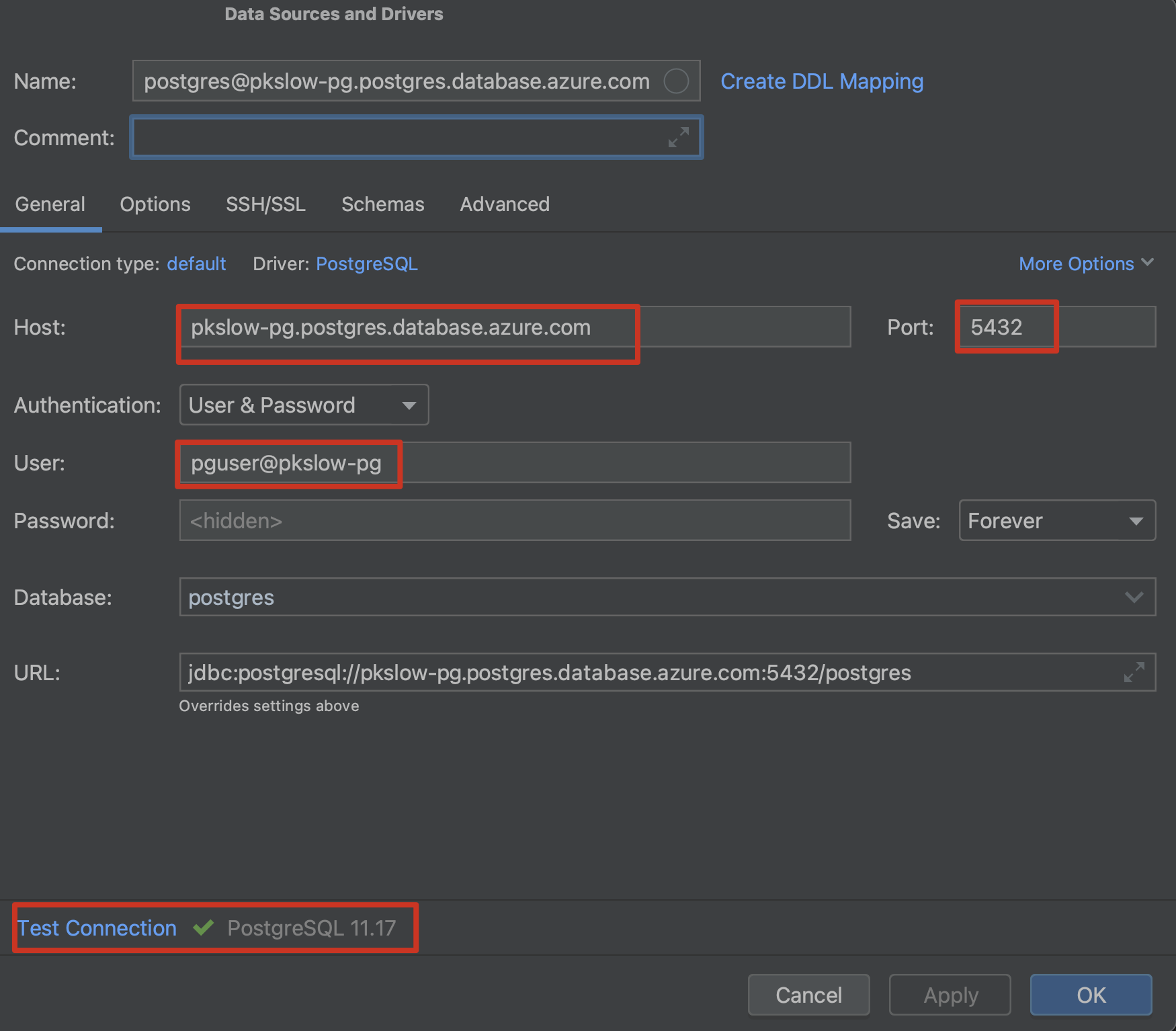
刪除資源
如果不需要再使用,就刪除資源:
az group delete --name pkslow-sql
通過Terraform創建Flexible Server
插件與版本
terraform {
required_version = ">= 1.1.3"
required_providers {
azurerm = {
source = "hashicorp/azurerm"
version = "3.38.0"
}
}
}
provider "azurerm" {
features {}
}
變數設置
variable "name_prefix" {
default = "pkslow-pg-fs"
description = "Prefix of the resource name."
}
variable "location" {
default = "eastus"
description = "Location of the resource."
}
main.tf創建
resource "random_pet" "rg-name" {
prefix = var.name_prefix
}
resource "azurerm_resource_group" "default" {
name = random_pet.rg-name.id
location = var.location
}
resource "azurerm_virtual_network" "default" {
name = "${var.name_prefix}-vnet"
location = azurerm_resource_group.default.location
resource_group_name = azurerm_resource_group.default.name
address_space = ["10.0.0.0/16"]
}
resource "azurerm_network_security_group" "default" {
name = "${var.name_prefix}-nsg"
location = azurerm_resource_group.default.location
resource_group_name = azurerm_resource_group.default.name
security_rule {
name = "test123"
priority = 100
direction = "Inbound"
access = "Allow"
protocol = "Tcp"
source_port_range = "*"
destination_port_range = "*"
source_address_prefix = "*"
destination_address_prefix = "*"
}
}
resource "azurerm_subnet" "default" {
name = "${var.name_prefix}-subnet"
virtual_network_name = azurerm_virtual_network.default.name
resource_group_name = azurerm_resource_group.default.name
address_prefixes = ["10.0.2.0/24"]
service_endpoints = ["Microsoft.Storage"]
delegation {
name = "fs"
service_delegation {
name = "Microsoft.DBforPostgreSQL/flexibleServers"
actions = [
"Microsoft.Network/virtualNetworks/subnets/join/action",
]
}
}
}
resource "azurerm_subnet_network_security_group_association" "default" {
subnet_id = azurerm_subnet.default.id
network_security_group_id = azurerm_network_security_group.default.id
}
resource "azurerm_private_dns_zone" "default" {
name = "${var.name_prefix}-pdz.postgres.database.azure.com"
resource_group_name = azurerm_resource_group.default.name
depends_on = [azurerm_subnet_network_security_group_association.default]
}
resource "azurerm_private_dns_zone_virtual_network_link" "default" {
name = "${var.name_prefix}-pdzvnetlink.com"
private_dns_zone_name = azurerm_private_dns_zone.default.name
virtual_network_id = azurerm_virtual_network.default.id
resource_group_name = azurerm_resource_group.default.name
}
resource "azurerm_postgresql_flexible_server" "default" {
name = "${var.name_prefix}-server"
resource_group_name = azurerm_resource_group.default.name
location = azurerm_resource_group.default.location
version = "13"
delegated_subnet_id = azurerm_subnet.default.id
private_dns_zone_id = azurerm_private_dns_zone.default.id
administrator_login = "pguser"
administrator_password = "QAZwsx123"
zone = "1"
storage_mb = 32768
sku_name = "GP_Standard_D2s_v3"
backup_retention_days = 7
depends_on = [azurerm_private_dns_zone_virtual_network_link.default]
}
準備文件:pg-fs-db.tf
resource "azurerm_postgresql_flexible_server_database" "default" {
name = "${var.name_prefix}-db"
server_id = azurerm_postgresql_flexible_server.default.id
collation = "en_US.UTF8"
charset = "UTF8"
}
輸出結果
output "resource_group_name" {
value = azurerm_resource_group.default.name
}
output "azurerm_postgresql_flexible_server" {
value = azurerm_postgresql_flexible_server.default.name
}
output "postgresql_flexible_server_database_name" {
value = azurerm_postgresql_flexible_server_database.default.name
}
執行
準備好hcl文件後,執行如下:
$ terraform init
$ terraform plan -out main.tfplan
$ terraform apply main.tfplan
Apply complete! Resources: 10 added, 0 changed, 0 destroyed.
Outputs:
azurerm_postgresql_flexible_server = "pkslow-pg-fs-server"
postgresql_flexible_server_database_name = "pkslow-pg-fs-db"
resource_group_name = "pkslow-pg-fs-delicate-honeybee"
創建成功後,可以查看:
$ az postgres flexible-server list --output table
Name Resource Group Location Version Storage Size(GiB) Tier SKU State HA State Availability zone
------------------- ------------------------------ ---------- --------- ------------------- -------------- --------------- ------- ---------- -------------------
pkslow-pg-fs-server pkslow-pg-fs-delicate-honeybee East US 13 32 GeneralPurpose Standard_D2s_v3 Ready NotEnabled 1
當然,在Portal上看也是可以的:
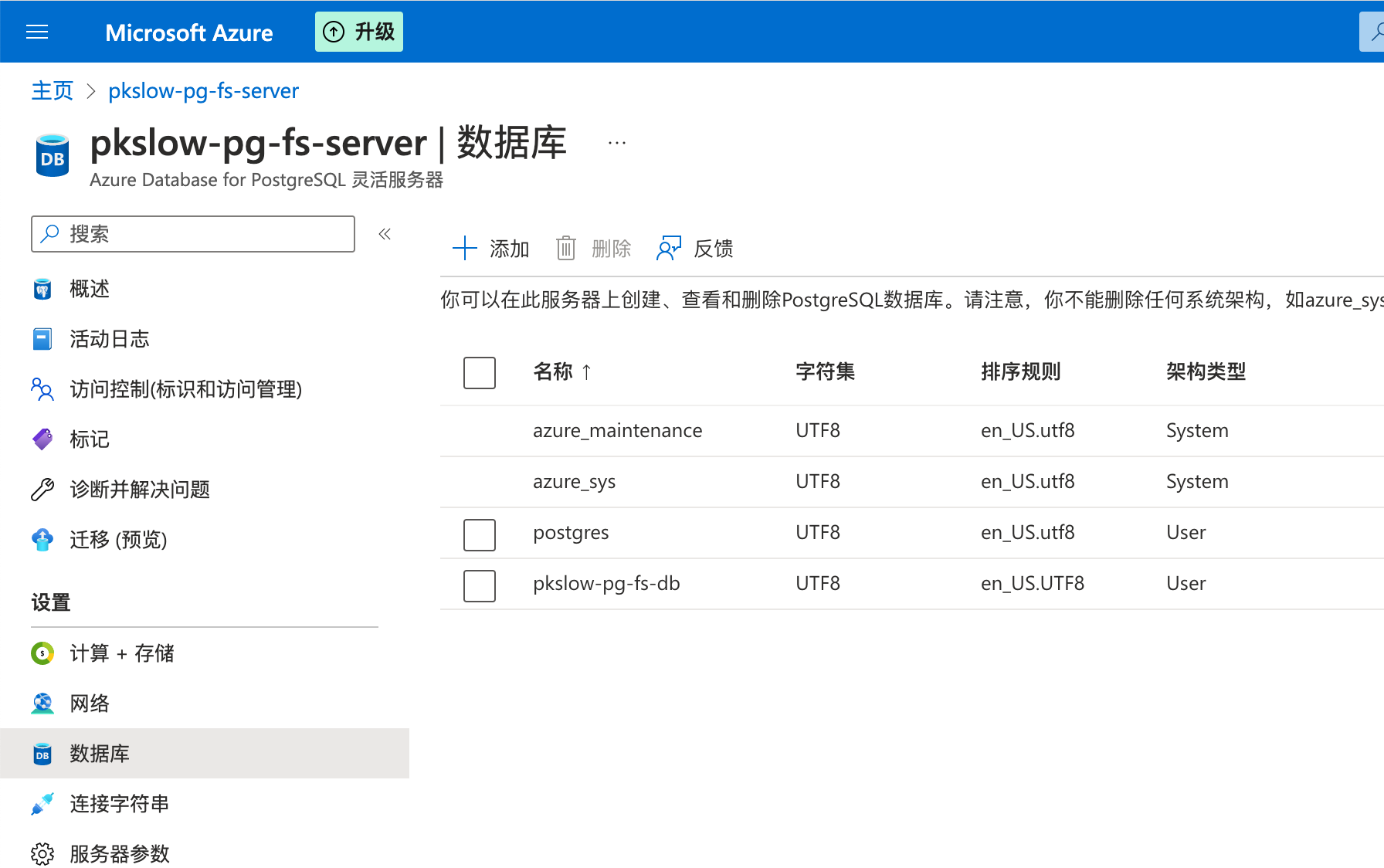
刪除
不需要了可以執行刪除:
terraform destroy
在Azure雲存儲上管理Terraform狀態
預設Terraform的狀態是保存在本地的,為了安全和協作,在生產環境中一般要保存在雲上。
創建Azure Storage
我們創建Storage來存儲Terraform狀態。按下麵一步步執行即可:
RESOURCE_GROUP_NAME=pkslow-tstate-rg
STORAGE_ACCOUNT_NAME=pkslowtfstate
CONTAINER_NAME=tfstate
# Create resource group
az group create --name $RESOURCE_GROUP_NAME --location "West Europe"
# Create storage account
az storage account create --resource-group $RESOURCE_GROUP_NAME --name $STORAGE_ACCOUNT_NAME --sku Standard_LRS --encryption-services blob
# Get storage account key
ACCOUNT_KEY=$(az storage account keys list --resource-group $RESOURCE_GROUP_NAME --account-name $STORAGE_ACCOUNT_NAME --query [0].value -o tsv)
# Create blob container
az storage container create --name $CONTAINER_NAME --account-name $STORAGE_ACCOUNT_NAME --account-key $ACCOUNT_KEY
echo "storage_account_name: $STORAGE_ACCOUNT_NAME"
echo "container_name: $CONTAINER_NAME"
echo "access_key: $ACCOUNT_KEY"
Terraform backend
創建完Storage後,我們需要在Terraform中配置使用:
terraform {
required_version = ">= 1.1.3"
required_providers {
azurerm = {
source = "hashicorp/azurerm"
version = "3.38.0"
}
local = {
source = "hashicorp/local"
version = "= 2.1.0"
}
}
backend "azurerm" {
resource_group_name = "pkslow-tstate-rg"
storage_account_name = "pkslowtfstate"
container_name = "tfstate"
key = "pkslow.tfstate"
}
}
provider "azurerm" {
features {}
}
resource "local_file" "test-file" {
content = "https://www.pkslow.com"
filename = "${path.root}/terraform-guides-by-pkslow.txt"
}
主要代碼是這塊:
backend "azurerm" {
resource_group_name = "pkslow-tstate-rg"
storage_account_name = "pkslowtfstate"
container_name = "tfstate"
key = "pkslow.tfstate"
}
這裡前三個變數的值都是前面創建Storage的時候指定的。
執行Terraform
初始化:
$ terraform init
Initializing the backend...
Initializing provider plugins...
- Finding hashicorp/local versions matching "2.1.0"...
- Finding hashicorp/azurerm versions matching "3.38.0"...
- Installing hashicorp/local v2.1.0...
- Installed hashicorp/local v2.1.0 (unauthenticated)
- Installing hashicorp/azurerm v3.38.0...
- Installed hashicorp/azurerm v3.38.0 (signed by HashiCorp)
Terraform has created a lock file .terraform.lock.hcl to record the provider
selections it made above. Include this file in your version control repository
so that Terraform can guarantee to make the same selections by default when
you run "terraform init" in the future.
Terraform has been successfully initialized!
You may now begin working with Terraform. Try running "terraform plan" to see
any changes that are required for your infrastructure. All Terraform commands
should now work.
If you ever set or change modules or backend configuration for Terraform,
rerun this command to reinitialize your working directory. If you forget, other
commands will detect it and remind you to do so if necessary.
看日誌就會初始化backend。
執行apply:
$ terraform apply -auto-approve
Acquiring state lock. This may take a few moments...
Terraform used the selected providers to generate the following execution plan. Resource actions are indicated with the following symbols:
+ create
Terraform will perform the following actions:
# local_file.test-file will be created
+ resource "local_file" "test-file" {
+ content = "https://www.pkslow.com"
+ directory_permission = "0777"
+ file_permission = "0777"
+ filename = "./terraform-guides-by-pkslow.txt"
+ id = (known after apply)
}
Plan: 1 to add, 0 to change, 0 to destroy.
local_file.test-file: Creating...
local_file.test-file: Creation complete after 0s [id=6db7ad1bbf57df0c859cd5fc62ff5408515b5fc1]
Releasing state lock. This may take a few moments...
Apply complete! Resources: 1 added, 0 changed, 0 destroyed.
然後我們去查看Azure Storage,就可以發現已經生成一個Terraform狀態文件:
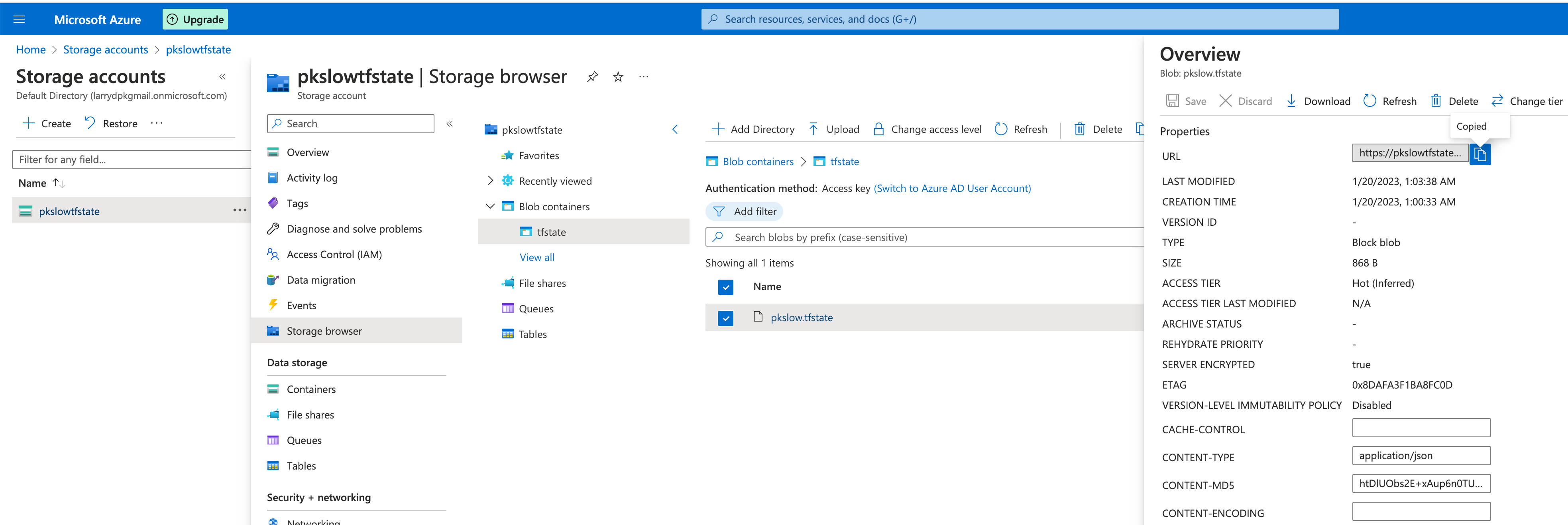
如果不再使用,記得刪除資源。



